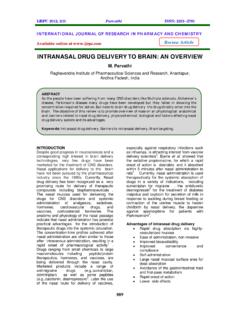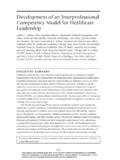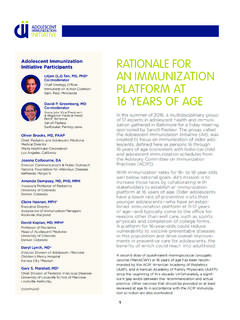Transcription of PHARMACOVIGILANCE: AN OVERVIEW - IJRPC
1 IJRPC 2011, 1(4) Babita Ravindra Alhat et al. ISSN: 2231 2781 968 INTERNATIONAL JOURNAL OF RESEARCH IN pharmacy AND CHEMISTRY Available online at pharmacovigilance : AN OVERVIEW Babita Ravindra Alhat Vishal Junnar Seva Mandal's, Institute of pharmacy , Ale, Junnar, Pune, Maharashtra, India. *Corresponding Author: INTRODUCTION pharmacovigilance is an important and integral part of clinical research1. Both clinical trials safety and post marketing pharmacovigilance are critical throughout the product lifecycle. pharmacovigilance is defined as the pharmacological science relating to the detection, assessment, understanding and prevention of adverse effects, particularly long term and short term adverse effects of medicines.
2 pharmacovigilance is still in its infancy in India and there exists very limited knowledge about the discipline. While major advancements of displine of pharmacovigilance have taken place in the western countries not much has been achieved in India. There is an immense need to understand the importance of pharmacovigilance and how it impacts the life cycle of the product. This will enable integration of good pharmacovigilance practice in the process and procedures to help ensure regulatory compliance and enhance clinical trials safety and post marketing surveillance. pharmacovigilance is not new to India and has infact been going on from 19982. When India decided to join the uppasla centre for adverse event monitoring.
3 The importance of pharmacovigilance is withdrawls the regulatory agencies, media; consumers have become more aware about the benefit and risks of medicines. An adverse event is defined as any un toward medical occurrence that may present during treatment with a drug but which does not necessarily have a relationship with its use. An adverse drug reaction is any noxious, unintended and undesired effect of a drug, which occurs at a dose used in human for prophylaxis, diagnosis, therapy or modification of physiological function. Spontaneous reporting of adverse drug reaction and adverse events is an important tool for gathering the safety information for early detection. In recent years many Indian companies are increasing the investment in Review Article ABSTRACT pharmacovigilance is an important and integral part of clinical research.
4 pharmacovigilance is defined as the pharmacological science relating to the detection, assessment, understanding and prevention of adverse effects, particularly long term and short term adverse effects of medicines. Here the main focus on the aims and role of pharmacovigilance in medicines regulation and their Partners. This article describes and discusses the National programme of pharmacovigilance and centre in India. There role in collecting the reports ADRs of medicines. Further effectiveness and risk assessments of therapies are been discussed. The important role played by health care professional, pharmaceutical industries, media, and programmes carried by WHO. Finally the conclusion describes the major challenges and achievements for the future pharmacovigilance safety and toxicity is not so critical if botanicals are used in traditional forms (Harborne.)
5 , 1998). IJRPC 2011, 1(4) Babita Ravindra Alhat et al. ISSN: 2231 2781 969 research and development and are enhancing their capacity to develop and market new drugs with their own research efforts. Further India is becoming a hub for clinical research activities due to its large population, high enrolment rate and low cost 3. Moreover, the lag period when a drug is placed for the first time on the market in USA, Europe, and Japan or somewhere in the world and its subsequent availability in India has decreased considerably. As a result, for such drugs the long term safety data is not available and the time of their marketing in India. This is clear by the fact that all the high profile drugs that have been recently withdrawn were available in Indian market.
6 In such cases, the Indian regulatory agencies cannot count on the experience of other market to assess benefit risk balance of a drug. There by stressing the importance of developing their own adequately designed pharmacovigilance system in India. For an effective pharmacovigilance system to be functional and efficient, all the stake holders need to be alert and attentive throughout the life cycle of a medicinal product in the market .The office of the Drugs Controller General of India(DCGI) has been making sincere attempts for the implementation the National pharmacovigilance programme (NPP) in India. To full fill the pharmacovigilance obligations for its marketed products, as per regulations, a generic company in India is mainly to carry out the following activities.
7 Collection monitoring, and reporting of spontaneous adverse reactions, including expedited reporting of serious unexpected adverse reactions and preparations. pharmacovigilance help to prevent adverse drug effects: Medical science has grown in leaps and bounds since the days of Hippocrates. Modern day pharmaceutical drugs are really life saves. They have increased life expectancy and improved the quality of life for millions of people. But there is the other side of the coin as well; these drugs sometimes have very adverse effects that can even be life threating. WHAT IS pharmacovigilance ? There is a need to monitor the effects of drugs before and after it s successfully tested and launched in the market.
8 pharmacovigilance involves monitoring and assessing the quality IJRPC 2011, 1(4) Babita Ravindra Alhat et al. ISSN: 2231 2781 970 of drugs, detection and preventing of any adverse effects of drugs. pharmacovigilance involves evaluating information provided by health care providers, pharmaceutical companies and patients in order to understand the risks and benefits involved with a particular drug. Pharmaceutical companies spend millions of dollars and a considerably long time in developing new drugs. They again spend a lot of money in conducting clinical trials before the drugs are approved and launched in the market. It is recognized that information technology (IT) has entered and transformed the world of health care and clinical medicine in which the work of doctors and the care of patients proceed with higher quality, efficiency and lower costs.
9 It is also no secret that IT has merged in to clinical safety practice and sparks the creation of worldwide pharmacovigilance systems for safety signal detection. The IT transformative force and health it adoption have fundamentally changed the conduct of clinical research, practice of medicines, and medicinal safety monitoring. In today s world, pharmacovigilance pushes new boundaries and it is no longer sufficient to simply report adverse events along with efficacy and quality requirements. Regulators are demanding proactive surveillance programs that include comprehensive risk management plans and signal detection /analysis throughout a clinical products life cycle. This addresses what exactly is pharmacovigilance ? What do we know of its benefits and risks?
10 What challenges are out there preventing its wide spread usage? And what does the future hold for pharmacovigilance in worldwide medicine? It is now generally accepted that part of the process of evaluating drug safety needs to happen in the post marketing phases through judgment as to whether and how this might happen lies with the regulators. The stronger the national systems of pharmacovigilance and adverse drug reaction (ADR) reporting, the more likely reasonable regulatory decisions will be made for the early release of new drugs with the promise of therapeutic advances. Care full safety monitoring is not restricted, however to new drugs or to significant therapeutic advances. It has a critical role to play in the introduction of generic medicines, and in review of the safety profile of older medicines already available as well, where new safety issues may have arises.











